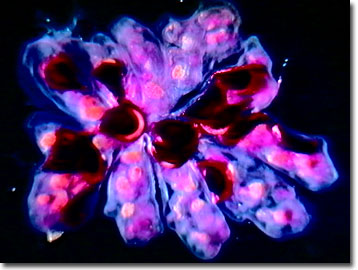Darkfield Digital Image Gallery
Pectinatella Bryozoans
Resembling gelatinous detritus or aquatic plant growth on submerged sticks and other substrates, bryozoans are primarily marine, but are also found in freshwater rivers and impoundments. Commonly referred to as the moss animals, these sessile colonial creatures were thought to be plants similar to their ecological analogs, the corals, until the mid-1700s. Of the thousands of species worldwide, one class, Phylactolaemata, is found exclusively in fresh water. Known as the jelly blobs or simply "blobs", Pectinatella magnifica is a relatively common North American freshwater species of the phylum Ectoprocta.

View a high magnification image of Pectinatella.
As with other bryozoans, each colony of Pectinatella is a collection of genetically identical zooids, which exude a gelatin-like protective matrix of exopolymers (polysaccharides and glycoproteins) that is mostly composed of water. The surface of the colony is divided into rosettes of 12 to 18 zooids. Up to two million zooids may be found in a single massive colony, which may exceed two feet in diameter. More typically, however, the freshwater bryozoan colony is one foot or less across. The colonies are known to grow extremely rapidly, doubling in size in about four days at favorable water temperatures and in suitable environments.
Pectinatella feed on aquatic plants and animals including diatoms, algae, bacteria, and rotifers, using their lophophores. Lophophores are specialized feeding devices consisting of whorls with delicate ciliated tentacles borne on a ridge surrounding the mouths of the individual zooids. When not feeding, the flower-like food-gathering structures are collapsed and completely withdrawn into the interior of the colony. The epistome, a special lobe that hangs over the mouth of the zooid, is believed to have an important sensory function.
When disturbed, jelly blobs emit a pungent odor from chemicals released by the colony when threatened by fish predation or to prevent competition for growing space. Although harmless to humans, large Pectinatella colonies can clog water intake pipes, creating economic and engineering challenges.
Contributing Authors
Cynthia D. Kelly, Thomas J. Fellers and Michael W. Davidson - National High Magnetic Field Laboratory, 1800 East Paul Dirac Dr., The Florida State University, Tallahassee, Florida, 32310.
BACK TO THE DARKFIELD IMAGE GALLERY
BACK TO THE DIGITAL IMAGE GALLERIES
Questions or comments? Send us an email.
© 1995-2025 by Michael W. Davidson and The Florida State University. All Rights Reserved. No images, graphics, software, scripts, or applets may be reproduced or used in any manner without permission from the copyright holders. Use of this website means you agree to all of the Legal Terms and Conditions set forth by the owners.
This website is maintained by our
Graphics & Web Programming Team
in collaboration with Optical Microscopy at the
National High Magnetic Field Laboratory.
Last Modification Friday, Nov 13, 2015 at 01:19 PM
Access Count Since September 17, 2002: 14349
Visit the website of our partner in introductory microscopy education:
|
|
